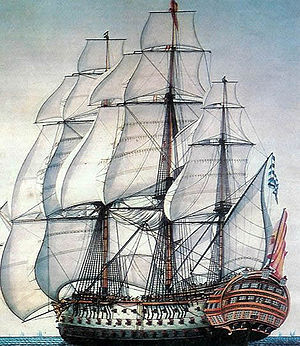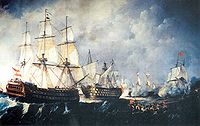- Spanish ship Nuestra Señora de la Santísima Trinidad
-

Santísima TrinidadCareer 
Launched: Havana, Cuba, 3 March 1769 Fate: Wrecked 22 October 1805 General characteristics Class and type: 140-gun first rate Displacement: 4,950 tons Length: 61.3 m (201 ft) Beam: 16.2 m (53 ft) Draught: 8.02 m (26.3 ft) Complement: 1,050 Armament: 112 guns as built:
lower deck 30 × 36 pdrs,
middle deck 32 × 24 pdrs,
upper deck 32 × 12 pdrs,
quarterdeck and forecastle 18 × 8 pdrs.The Santísima Trinidad (officially named Santísima Trinidad by Royal Order on 12 March 1768, nicknamed La Real and sometimes confused with the Manila galleon Santísima Trinidad y Nuestra Señora del Buen Fin [1751]) was a Spanish first-rate ship of the line of 112 guns, which was increased in 1795–96 to 130 guns by closing in the spar deck between the quarterdeck and forecastle, and around 1802 to 140 guns, thus creating what was in effect a continuous fourth gundeck although the extra guns added were actually relatively small. She was the heaviest-armed ship in the world when rebuilt, and bore the most guns of any ship of the line outfitted in the Age of Sail.
Contents
Design & construction
She was built at Havana, Cuba, to a design by Irish naval architect Matthew Mullan (domiciled in Spain under the name Mateo Mullán) and launched in 1769 as an 112-gun three-decker [1] (some sources say 116 or even 120 guns). She was considerably larger than her British contemporary Victory and somewhat bigger than the French Bretagne.
There is no complete plan of the ship in existence, but there are of the 112-gun ship from 1765, from which the original dimensions of the ship may be found. Here, the units of length are the Spanish Burgos foot (27.86 cm) and the SI metre (100 cm), respectively: length = 2132⁄3 (59.53); keel = 1825⁄12 (50.82); beam = 573⁄4 (16.09); draught = 2811⁄12 (8.06).[Note 1]
In 1795, her forecastle was joined to her quarterdeck to create a fourth deck containing a battery of eight pounder guns, giving her a total of 140 guns. Her armament seems to have been quickly reduced to 130 from 136 guns, but she still carried more guns than any other ship of her time. As the only ship with four gun decks, she was reputed to be the largest warship in the world, for which she was nicknamed El Escorial de los mares by the Spanish, until surpassed in sheer size by the new type French 120-gun ships such as the Océan (1790) and Orient (1791).
The weight of the additional guns, so high above her waterline, made her sail poorly, leading to her nickname, El Ponderoso.[2] It was even suggested by some naval officers that she should be restricted to the defense of the Bay of Cádiz.
Santísima Trinidad remains famous as one of the few four-decker ships of the line ever built. The U.S. Navy constructed the four-deck, 136-gun Pennsylvania and the French - Valmy (both with similar flush deck arrangement), and the Royal Navy planned—but did not actually build—the proper four-deck Duke of Kent.
Service
In July 1779, Spain declared war on Great Britain, joining France in support of the American colonists in the American War of Independence. Santísima Trinidad became the flagship of the Spanish fleet, taking part in the Franco-Spanish operations in the English Channel in the late summer of that year.[citation needed]
In August 1780 she took part in the capture of 55 ships from a British convoy of 63, escorted by the ship of the line HMS Ramillies and three frigates.[3] In 1782 she was incorporated into the Mediterranean Squadron, participating in the second siege of Gibraltar and she fought in the brief and indecisive Battle of Cape Spartel.[citation needed] In 1795, she was modified by the addition of extra 8-pounder guns on a new deck between her forecastle and quarterdeck.[citation needed]
In 1797, she was the flagship of Teniente General José de Córdoba, the Spanish commander, at Battle of Cape St Vincent on 14 February 1797, where she was badly damaged and nearly captured by the British fleet. She was first in action with the British ship Captain (74), commanded by Commodore Nelson, and Culloden (74). She was then attacked by the Blenheim (90), Orion (74), Irresistible (74) and Excellent (74). By now she was severely damaged, having lost all her masts and with half of her crew killed or wounded. She struck her colours, but the British failed to take possession and she was saved by the Pelayo (74) and Principe de Asturias (112). Several days later, Santísima Trinidad was spotted, still damaged, making her way back to Spain, and engaged by the 32-gun frigate HMS Terpsichore under Captain Richard Bowen, but she escaped. She eventually returned to Cadiz for repairs.[citation needed]
Eight years later, commanded by Francisco Javier Uriarte and Rear Admiral Baltasar Hidalgo de Cisneros, she took part in the Battle of Trafalgar on October 21, 1805, as part of the combined Franco-Spanish fleet. Due to her great bulk, her helm was unresponsive in the light winds of the day, contributing to her ineffective service of the combined fleet's cause.[citation needed] Her great size and position immediately ahead of the fleet flagship Bucentaure made her a target for the British fleet, and she came under concentrated attack by several ships. She lost her mast and eventually surrendered to the Neptune, commanded by Captain Thomas Fremantle. She was taken in tow by the Prince,[4] but sank in a storm the day after the battle having been scuttled by her British captors.[5]
Replicas
A full-size mimicry [6] of the Santísima Trinidad can be seen and visited in the harbour of Alicante, in Spain. In 2006 a merchant ship was fitted to mimic the appearance of the Santísima Trinidad, therefore not being a true replica. The conversion was begun in Galicia, where the original steel hull was given a first coating of fake wood strakes and erection of the masts. Stern galleries, the deck furniture and the rigging were made in Algeciras. Finally the boat was towed to be moored in the port of Malaga, where he was used as a floating restaurant, nightclub and showroom. The original engine was retained, and the boat is able to cruise around the vicinity of Malaga for recreation purposes.
A non-profit non-governmental Canadian association, the Friends of Santísima Trinidad,[7] is assisting the Office of the Historian of the City of Havana, Cuba with the construction of a new 1:25 four-metre-long scale model of La Santísima Trinidad. Interior construction details will be exposed on one side of the vessel, and visitors will be able to use a computer interface and touch screen to take a virtual tour of the ship in Spanish, English, and French. The model will be displayed in the Naval Museum of La Habana, opened in June 2008 at Castillo de la Real Fuerza, the oldest building in Cuba and the oldest stone fortress in the New World.
Not to be confused with
- Santísima Trinidad y Nuestra Señora del Buen Fin, a Manila Galleon, captured by the British in the Battle of Manila (1762).
Notes
- ^ For exact figures, and those in the General characteristics frame, see: José Cayuela Fernandez, Trafalgar, hombres y naves entre dos épocas: Ariel (2004)
Sources & references
- ^ Gervasio de Artinano y de Galdacano, La Arquitectura Naval Espanola (en Madera) (Madrid 1920), p.365
- ^ El Ponderoso, the ponderous is a pun on el poderoso, the mighty.
- ^ Harbron, John: Trafalgar and the Spanish Navy. Conway Maritime Press, 1988, page 84. ISBN 0851774776
- ^ Fremont-Barnes, Gregory and Hook, Christa: Trafalgar 1805: Nelson's crowning victory. Osprey Publishing, 2005, page 23. ISBN 1841768928
- ^ Fremont-Barnes and Hook, page 81
- ^ barco restaurante-barco discoteca-santisimatrinidad-puerto malaga
- ^ The Mission to construct a replica of Santísima Trinidad in Havana
Additional reading
- John D. Harbron Trafalgar and the Spanish Navy (1988) ISBN 0870216953
- José Cayuela Fernandez - Trafalgar, hombres y naves entre dos épocas - Ariel (Barcelona) 2004 ISBN 84344676070
External links
Categories:- Spanish Navy ships of the line
- Shipwrecks in the Atlantic Ocean
- Replica ships
- 1760s ships
- Maritime incidents in 1805
Wikimedia Foundation. 2010.



